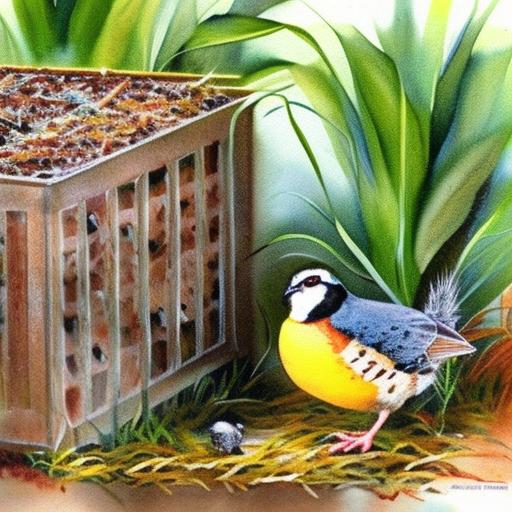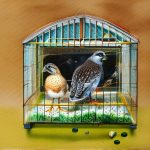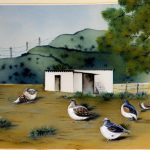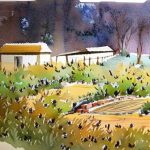Quail are small birds that have specific needs when it comes to breeding. They require a comfortable and safe environment to thrive and reproduce. Quail need enough space to move around, as overcrowding can lead to stress and aggression. They also need a warm and dry environment, as they are sensitive to cold and damp conditions. Additionally, quail need a balanced diet that includes a mix of grains, seeds, and insects to ensure their health and reproductive success. Understanding these needs is crucial when designing and constructing breeding cages for quail.
Quail also have specific breeding behaviors that need to be taken into consideration. They are ground-nesting birds, so they require nesting areas with suitable materials such as straw or hay. Quail also need privacy during the breeding process, so the cages should be designed to provide secluded areas for nesting and egg-laying. Furthermore, quail are social birds and thrive in groups, so the cages should be designed to accommodate multiple birds while still providing enough space for each individual. Taking these needs into account is essential for creating a suitable environment for quail breeding.
Key Takeaways
- Quail need a quiet and stress-free environment for breeding
- Choose materials that are easy to clean and provide good ventilation for the cages
- Design the layout to maximize space and provide separate areas for nesting and feeding
- Construct sturdy cages that are easy to assemble and disassemble for cleaning
- Add features such as nesting boxes, perches, and feeders to meet the needs of breeding quail
- Regularly clean and disinfect the cages to prevent the spread of diseases
- Monitor the temperature, humidity, and cleanliness of the cages to ensure the health and safety of the quail
Choosing the right materials for the cages
When it comes to choosing materials for quail breeding cages, there are several factors to consider. The materials need to be durable and easy to clean, as maintaining a clean environment is crucial for the health and well-being of the quail. Additionally, the materials should be non-toxic and safe for the birds, as they may peck and ingest parts of the cage. Wire mesh is a popular choice for the walls and floors of quail cages, as it allows for good ventilation and is easy to clean. It is important to choose a mesh size that is appropriate for quail, as smaller birds may get their feet caught in larger mesh sizes.
For the frame of the cages, materials such as wood or metal can be used. Wood provides a natural and insulating environment for the quail, while metal is more durable and long-lasting. The choice of material will depend on factors such as climate, budget, and personal preference. It is important to ensure that the materials are sturdy and secure, as quail can be skittish and may attempt to escape if they feel unsafe. Overall, choosing the right materials for the cages is essential for creating a comfortable and safe environment for quail breeding.
Designing the layout of the breeding cages
The layout of the breeding cages plays a crucial role in creating a suitable environment for quail breeding. The cages should be designed to provide enough space for the quail to move around comfortably, as well as areas for nesting, feeding, and drinking. The layout should also take into account the social nature of quail, providing enough space for multiple birds to coexist without overcrowding. Additionally, the cages should be designed to allow for easy access for cleaning and maintenance.
Nesting areas are an important consideration when designing the layout of quail breeding cages. Quail prefer secluded and private areas for nesting and egg-laying, so the cages should include designated nesting boxes or areas with suitable materials such as straw or hay. These areas should be easily accessible for collecting eggs while still providing privacy for the birds. Feeding and drinking areas should also be carefully placed within the cages to ensure easy access for the quail while minimizing waste and mess. Overall, designing the layout of the breeding cages requires careful consideration of the needs and behaviors of quail to create a comfortable and functional environment for breeding.
Constructing the cages
Constructing quail breeding cages requires attention to detail and precision to ensure a safe and secure environment for the birds. The cages should be sturdy and well-built to prevent escapes and protect the quail from predators. When constructing the cages, it is important to follow a detailed plan or design to ensure that all components are assembled correctly and securely. This may involve cutting and shaping materials such as wood or metal, as well as attaching wire mesh for walls and floors.
Proper ventilation is also an important consideration when constructing quail breeding cages. The cages should allow for good airflow while still providing protection from drafts and extreme temperatures. This may involve adding vents or windows to the design of the cages to ensure that the quail have access to fresh air without being exposed to harsh weather conditions. Additionally, attention should be paid to details such as door latches and locks to prevent escapes and ensure the safety of the birds. Overall, constructing quail breeding cages requires careful planning and attention to detail to create a safe and comfortable environment for the birds.
Adding necessary features for quail breeding
In addition to providing space for nesting, feeding, and drinking, there are several other features that can be added to quail breeding cages to enhance the environment for the birds. Perches or roosts can be added to provide elevated resting areas for the quail, as they are ground-dwelling birds that may appreciate higher vantage points. These perches can be made from natural materials such as branches or wooden dowels to provide a comfortable and natural resting area for the birds.
Another important feature to consider is lighting. Quail require a consistent day-night cycle to regulate their reproductive behavior, so adding artificial lighting to the breeding cages can help simulate natural daylight hours. This can encourage egg-laying and breeding behavior in the quail, especially during the winter months when daylight hours are shorter. Additionally, providing a source of heat such as heat lamps or heating pads can help maintain a warm and comfortable environment for the birds, especially in colder climates.
Finally, providing enrichment items such as dust baths or toys can help keep the quail stimulated and reduce stress in the breeding cages. Dust baths are important for maintaining healthy feathers and skin in quail, while toys such as hanging mirrors or pecking blocks can provide mental stimulation and entertainment for the birds. Overall, adding necessary features to quail breeding cages can help create a comfortable and enriching environment for the birds.
Maintaining the breeding cages

Maintaining quail breeding cages is essential for ensuring the health and well-being of the birds. Regular cleaning and sanitation are crucial for preventing disease and maintaining a comfortable environment for the quail. This may involve removing soiled bedding, replacing nesting materials, and cleaning food and water dishes on a regular basis. Additionally, it is important to inspect the cages for any signs of wear or damage that may compromise the safety of the birds.
Monitoring the temperature and humidity levels in the breeding cages is also important for maintaining a comfortable environment for the quail. This may involve using thermometers and hygrometers to ensure that the cages are within an appropriate range for the birds’ needs. Making adjustments such as adding insulation or ventilation can help regulate temperature and humidity levels as needed.
Regular health checks are also important for maintaining quail breeding cages. This may involve monitoring the birds for signs of illness or injury, as well as providing regular veterinary care as needed. Keeping detailed records of health and breeding activity can help identify any issues early on and ensure that the birds receive proper care.
Ensuring the health and safety of the quail
Ensuring the health and safety of quail in breeding cages requires attention to detail and proactive measures to prevent illness and injury. Providing a balanced diet with access to clean water is essential for maintaining the overall health of the birds. This may involve offering a mix of grains, seeds, insects, and commercial feed to ensure that the quail receive all necessary nutrients.
Preventing disease is also important for ensuring the health of quail in breeding cages. This may involve implementing biosecurity measures such as quarantining new birds before introducing them to existing flocks, as well as regularly disinfecting cages and equipment to prevent the spread of illness. Additionally, monitoring for signs of illness such as lethargy, loss of appetite, or changes in behavior can help identify issues early on.
Protecting quail from predators is another important aspect of ensuring their safety in breeding cages. This may involve using secure locks on doors and windows, as well as adding additional barriers such as predator-proof wire mesh or fencing around outdoor enclosures. Providing sheltered areas within the cages can also help protect quail from predators such as hawks or raccoons.
Overall, ensuring the health and safety of quail in breeding cages requires proactive measures to prevent illness, injury, and predation. By providing a comfortable environment with proper nutrition, sanitation, and protection from predators, quail can thrive and reproduce successfully in breeding cages.
If you’re interested in building quail breeding cages, you may also want to learn about caring for goslings. Check out this informative article on how to care for goslings to gain insights into raising and nurturing young geese. Understanding the principles of caring for goslings can provide valuable knowledge that may be applicable to creating a suitable environment for quail breeding as well.
FAQs
What are quail breeding cages?
Quail breeding cages are specially designed enclosures used to house and breed quail. These cages provide a controlled environment for quail to lay eggs, incubate them, and raise their young.
What are the benefits of using quail breeding cages?
Quail breeding cages provide a safe and secure environment for quail to breed, which can help increase the success rate of hatching and raising healthy chicks. They also make it easier to monitor and manage the breeding process.
What materials are commonly used to build quail breeding cages?
Common materials used to build quail breeding cages include wire mesh, wood, PVC pipes, and metal frames. These materials are chosen for their durability, ease of cleaning, and ability to provide adequate ventilation and protection for the quail.
What are the key factors to consider when building quail breeding cages?
When building quail breeding cages, it’s important to consider the size of the cages, ventilation, access for cleaning, and the materials used. Additionally, the cages should be designed to provide enough space for the quail to move around comfortably and engage in natural behaviors.
Are there any specific design considerations for quail breeding cages?
Quail breeding cages should be designed to include nesting boxes for egg laying, perches for roosting, and a separate area for feeding and watering. The cages should also be easy to clean and maintain to ensure the health and well-being of the quail.
Are there any regulations or guidelines to follow when building quail breeding cages?
Regulations and guidelines for quail breeding cages may vary depending on location. It’s important to check with local authorities or agricultural agencies to ensure that the cages meet any necessary requirements for housing and breeding quail.
Meet Walter, the feathered-friend fanatic of Florida! Nestled in the sunshine state, Walter struts through life with his feathered companions, clucking his way to happiness. With a coop that’s fancier than a five-star hotel, he’s the Don Juan of the chicken world. When he’s not teaching his hens to do the cha-cha, you’ll find him in a heated debate with his prized rooster, Sir Clucks-a-Lot. Walter’s poultry passion is no yolk; he’s the sunny-side-up guy you never knew you needed in your flock of friends!







